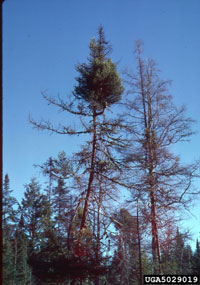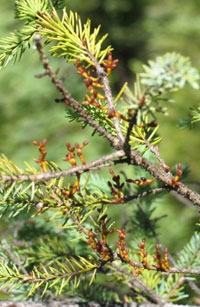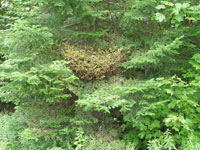Extension > Garden > Diagnose a problem > What's wrong with my plant? > Evergreen Trees and Shrubs > Spruce > Witches’ Broom
Spruce > Trunk or branches > Witches’ Broom
1 of 2
Eastern spruce dwarf mistletoe
Arceuthobium pusillum
- Witches’ brooms, a clump of small weak branches arising from one point on a larger branch, form in infected trees
- Needles within the witches’ broom remain green, needles on the rest of the tree yellow and fall off, typically from the top of the tree down
- Short (1/2 to 1 inch) brown to orange dwarf mistletoe stalks can be seen during the growing season but fall off after seed dispersal in August or September; this occurs only after 4 to 5 years of infection
- Most common on black spruce in northern Minnesota; white spruce are also very susceptible
- More information on Eastern spruce dwarf mistletoe
2 of 2
Spruce needle rust
Chrysomyxa spp.
- Needles at the tips of the branches (current year needles) turn yellow
- Pale orange to white tube like projections appear on infected needles in July or August and release powdery orange spores
- Severely infected trees may have a tan to pinkish cast
- Infected needles fall off in September
- Some species of rust can cause witches’ brooms, a clump of small weak branches arising from one point on a large branch
- More information on Spruce needle rust









